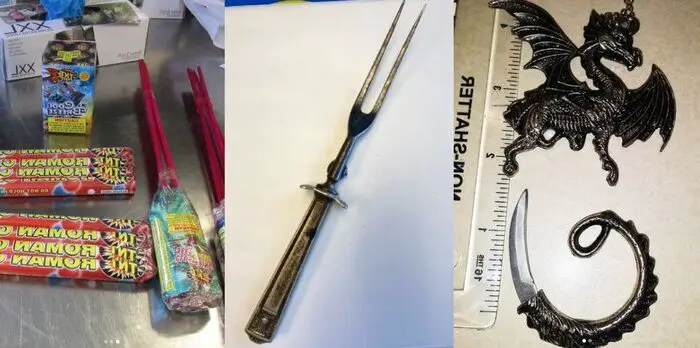Ever wondered what happens to items confiscated by TSA? Well, here’s the lowdown: once those prohibited items are discovered during security screenings, the TSA takes immediate action to ensure the safety of all passengers. You might be surprised to learn just how meticulous their process is. From a wide range of common items like pocket knives and liquids exceeding the designated limit, to more unusual finds like martial arts weapons or even live animals, the TSA deals with it all.
So, let’s unravel the fascinating journey of the items confiscated by TSA and dive into the captivating world of airport security protocols.
Table of Contents
What Happens to Items Confiscated by TSA?
Have you ever wondered what happens to those items that get confiscated by the Transportation Security Administration (TSA) at airport checkpoints? Whether it’s a forgotten water bottle or a prohibited weapon, TSA is responsible for ensuring the safety and security of air travel.
TSA’s Role in Security
Before we dive into the fate of confiscated items, it’s important to understand the role of TSA in aviation security. The TSA was established after the 9/11 terrorist attacks to enhance the security measures at airports and onboard aircraft. Their primary goal is to prevent any potential threats and ensure the safety of passengers.
Confiscation Process at Airport Security Checkpoints
When you pass through the airport security checkpoint, you are required to place your belongings, including personal items and carry-on bags, on the X-ray scanner belt. TSA officers monitor the images to identify any prohibited items or potential threats.
Let’s have a look at what TSA website says about it.

If an item is flagged as prohibited, TSA officers will confiscate it. Prohibited items can include firearms, sharp objects, explosives, flammable items, or items that pose a threat to aviation security. Once confiscated, the item goes through a specific process determined by the TSA.
Types of Confiscated Items
The list of prohibited items is extensive, and some of the most commonly confiscated items include:
- Knives, blades, and swords
- Firearms and ammunition
- Explosives and flammable materials
- Tools and sporting equipment
- Liquids and gels exceeding the permitted limit
- Replica firearms or weapons
- Improperly packed or undeclared hazardous materials
Immediate Disposal of Dangerous Items
If an item is deemed immediately dangerous or poses an immediate threat, TSA officers will take immediate action to ensure the safety of the airport and its occupants. This may involve calling the appropriate authorities, such as local law enforcement or bomb squads, to handle the situation. In such cases, the item will not go through the regular process and will be disposed of as per security protocols.
Read More: About What Does Price Per Person Double Occupancy Mean?
Confiscated Items at Security Checkpoints
Items that are not considered immediately dangerous are subjected to a different procedure. These items go through a series of steps, including inspection, documentation, and storage.
Inspection and Documentation
After confiscation, TSA officers inspect the item to determine its nature and potential threat level. They document the item’s details, including its description, size, and the location where it was found. This information is crucial for tracking and further handling of the items.
Storage of Confiscated Items
Once inspected and documented, the confiscated items are stored in secure containers or designated areas within the airport. These storage areas are typically restricted and accessible only to authorized personnel.
Donation Programs
In some cases, airports may have donation programs in place where certain non-hazardous items, such as scissors or pocket knives, can be donated instead of being confiscated. These items are typically collected and donated to charitable organizations or used by airport personnel for training purposes.
Transportation of Confiscated Items
At regular intervals, the TSA collects the confiscated items from various airports and transports them to centralized locations. These centralized locations could be TSA warehouses, government storage facilities, or other designated areas.
Auctioning Confiscated Items
Once the confiscated items reach the centralized location, they may go through an auctioning process. The TSA, in collaboration with other agencies or auction companies, may conduct public auctions to sell off the items. These auctions provide an opportunity for the public to bid on and purchase the confiscated items.
Recycling and Disposal
For items that are not suitable for auction or donation, the TSA follows environmentally responsible practices. These items, such as certain liquids, gels, or expired flares, are properly disposed of or recycled in accordance with applicable regulations to minimize their environmental impact.
TSA’s TSA’s Role in Education and Awareness
The TSA also plays a vital role in educating the public about prohibited items and airport security regulations. They aim to create awareness among passengers by providing guidelines and information through their website, social media channels, and signage at airports. By educating travelers, the TSA hopes to prevent the occurrence of prohibited items at security checkpoints, reducing the need for confiscation.
Preventing Confiscation
To avoid having your items confiscated at the airport security checkpoint, it’s essential to familiarize yourself with the TSA’s rules and regulations. Pack your bags carefully, ensuring that prohibited items are not included. Liquids and gels should be within the permitted limit and properly stored in a clear, resealable bag. Checking the TSA’s official website or contacting them directly can provide you with the most up-to-date information regarding what is allowed and what is not.
The TSA’s responsibility to ensure the safety of air travel involves the confiscation and handling of prohibited items. From immediate disposal of dangerous items to the auctioning or disposal of non-hazardous ones, confiscated items go through a carefully planned process. By understanding this process and staying informed about the TSA’s regulations, you can help ensure a smoother and safer journey through airport security checkpoints. Remember, it’s always better to leave prohibited items at home to avoid any inconvenience or delays during your travel.
Read More: About Why French Humor vs American Humor Is So Different?
Where do confiscated TSA items go? Try an auction
Frequently Asked Questions (FAQs)
When the Transportation Security Administration (TSA) confiscates items at airport security checkpoints, they follow specific procedures to ensure safety and compliance with regulations. Here are some frequently asked questions regarding the fate of confiscated items:
In general, you cannot retrieve confiscated items from TSA. Once an item is taken, it becomes the property of TSA, and their primary concern is aviation security. However, there may be exceptions for certain non-prohibited items.
Prohibited items, such as weapons or explosives, are typically handed over to local law enforcement for further investigation and disposal according to their protocols.
No, not all confiscated items are destroyed. Some items, like liquids above the carry-on limit, may be poured out. However, certain valuable items or items that pose no threat may be donated to charities or sold at government surplus auctions.
Confiscated electronics, such as laptops or smartphones, are generally not returned to individuals but are instead handed over to local authorities for further inspection or investigation.
Liquids, gels, and aerosols that exceed the allowable limit are typically disposed of by TSA. They may be poured out or placed in special containers for safe disposal.
TSA occasionally sells confiscated items that have no security concerns through government surplus auctions. The proceeds generated from these sales are used to fund further security initiatives.
Carrying prohibited items can lead to legal consequences, as they violate aviation security regulations. Depending on the severity and intent, you may face fines, penalties, or even criminal charges.
To prevent your items from being confiscated, familiarize yourself with TSA’s rules and regulations before traveling. Pack prohibited items in checked luggage or leave them at home to ensure a smoother security screening process.
Final Thoughts
Items confiscated by the TSA undergo a specific process. Once the security agents identify prohibited items, they are collected and routed to a separate area for examination. Depending on the object, passengers may have the option to return to the checkpoint to place it in their checked baggage.
Otherwise, the items are typically disposed of. In some cases, items of value or sentimental importance may be repurposed for other uses or donated to non-profit organizations. However, the majority of confiscated items are discarded to ensure the safety and efficiency of air travel.






